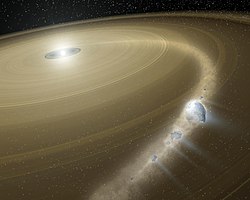| Observation data Epoch J2000.0 Equinox J2000.0 | |
|---|---|
| Constellation | Pisces [1] |
| Right ascension | 23h 28m 47.6365s [2] |
| Declination | +05° 14′ 54.235″ [2] |
| Apparent magnitude (V) | 13.03 [3] |
| Characteristics | |
| Spectral type | DAV4.4 [3] |
| U−B color index | −0.63 [3] |
| B−V color index | 0.14 [3] |
| V−R color index | 0.0 [4] |
| R−I color index | 0.2 [4] |
| Variable type | DAV (ZZ Ceti) [3] |
| Astrometry | |
| Radial velocity (Rv) | 15.3±3.0 [4] km/s |
| Proper motion (μ) | RA: −398.246(32) mas/yr [2] Dec.: −266.744(20) mas/yr [2] |
| Parallax (π) | 57.0620±0.0251 mas [2] |
| Distance | 57.16 ± 0.03 ly (17.525 ± 0.008 pc) |
| Details [5] | |
| Mass | 0.632±0.030 M☉ |
| Radius | 0.0124 R☉ |
| Luminosity | 0.00255 L☉ |
| Surface gravity (log g) | 8.048±0.005 cgs |
| Temperature | 11,635±178 K |
| Other designations | |
| ZZ Piscium, EGGR 159, GJ 895.2, LHS 5405, LTT 16907, NLTT 56992, WD 2326+049. [4] | |
| Database references | |
| SIMBAD | data |
Giclas 29-38 is a white dwarf in the constellation Pisces. A variable star, it bears the variable-star designation ZZ Piscium, and makes part of the DAV (or ZZ Ceti) variable type. Such stars display variability due to large-amplitude, non-radial pulsations known as gravity waves. It was first reported to be variable by Shulov and Kopatskaya in 1974. [6] [7] DAV stars are like normal white dwarfs but have luminosity variations with amplitudes as high as 30%, arising from a superposition of vibrational modes with periods from 100 to 1,000 seconds. Large-amplitude DAVs generally differ from lower-amplitude DAVs by having lower temperatures, longer primary periodicities, and many peaks in their vibrational spectra with frequencies which are sums of other vibrational modes. [8]
Contents

G29-38, like other complex, large-amplitude DAV variables, has proven difficult to understand. The power spectrum or periodogram of the light curve varies over times which range from weeks to years. Usually, one strong mode dominates, although many smaller-amplitude modes are often observed. The larger-amplitude modes, however, fluctuate in and out of observability; some low-power areas show more stability. Asteroseismology uses the observed spectrum of pulsations from stars like G29-38 to infer the structure of their interiors. [8]

